James Cassius Williamson: A Musical and Theatrical Legacy
Rare Music has a magnificent collection of Concert and Theatre Programs including a compilation of J.C. Williamson programs covering opera, drama, comedy theatre, musical, ballet and Gilbert & Sullivan. The collection provides a wealth of research material for anyone interested in the history of theatre in Australia. The précis of Williamson and the collection here intends to stimulate curiosity and establish the historical significance of the compilation in the annals of theatre in Australia.
James Cassius Williamson (1845–1913), actor and manager, and his actress wife, Maggie Moore came to Australia from America in 1874, with a new play called Struck Oil. The play’s huge financial success was to lay the foundation for the couple. They toured the play in India, England and America and returned to Australia in 1879 to form the Royal Comic Opera Company. They also returned with the rights of the Gilbert & Sullivan opera H.M.S. Pinafore and contracts for succeeding works by the duo. They gave their opening performance of H.M.S. Pinafore at the Theatre Royal, Sydney on 15 November 1879, both of them playing leading roles. This performance reflected Williamson’s innovativeness in modernising the Australian stage, producing stage shows that reflected the life of the time. Rather than reproduce Shakespearean drama—16th century “characters in doublet and hose”—“he brought [the stage] into intimate relation with the lives of plain people”. 1) To fill the roles Williamson brought out stars from America and England, but encouraged local talent when he could find it.
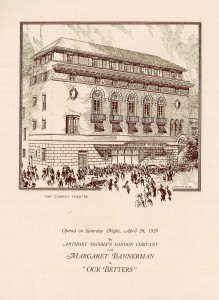
J.C. Williamson Theatres Ltd was established in 1879 by Williamson in partnership with George Musgrove and Arthur Garner. They became known as “The Triumvirate”. Their theatres included: Her Majesty’s, Melbourne; Comedy Theatre, Melbourne; Empire Theatre, Sydney; Theatre Royal, Sydney; His Majesty’s Brisbane; Theatre Royal, Adelaide; His Majesty’s Theatre, Auckland; Grand Opera House, Wellington; Theatre Royal, Christchurch. By 1911 J.C. Williamson’s Theatre Ltd had become known as “The Firm”. There were many variations to the partnership over the succeeding years. 2)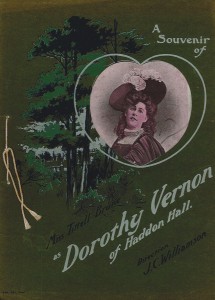
The Concert and Theatre program collection encompasses theatre and drama beginning with a 1906 souvenir of Miss Tittell Brune as “Dorothy Vernon of Haddon Hall” (Box 103 a). IMAGE?? Twenty-five years after the death of Williamson—and, I imagine, to his chagrin—there was a resurgence in Shakespearean plays, performed by international companies such as: John Alden Company (Box 103 c); The Shakespeare Memorial Theatre Company (Box 103 b); The Old Vic Company featuring Katherine Hepburn and Robert Helpmann (Box 103 e); and The Royal Shakespeare Company featuring Judi Dench (Box 103 j). Australian plays such as Peter Scriven’s Tintookies (Box 103 f), however, were also promoted.
On 28 April 28 1928 the doors opened at The Comedy Theatre, on the historic site of The Iron Pot “bring[ing] to fruition…. an intimate theatre … form[ing] the coping stone of the worldwide organisation of J. C. Williamson Ltd …” 3) Performances ranged from solo artists such as Maurice Chevalier (Box 104 b) to plays like A Streetcar Named Desire (Box 104 d) and Australian productions as Ray Lawler’s Summer of the Seventeenth Doll (Box 104 f). The opera collection also encompasses The Melba Grand Opera Season of 1911 (Box 105 a), which was touted as the greatest musical occasion in the history of Australia. The Quinlan Grand Opera Season (Box 105 b–c) followed in 1912–13. The Williamson & Dame Nellie Melba Grand Opera Seasons of 1924 and 1928 (Box 105 d–g) included the 1924 farewell performance of Melba in La Boheme (Box 105 f). Further opera collaborations were formed from 1948–58. A major landmark in the establishment of opera in Australia was in 1965 with the return of Joan Sutherland and Richard Bonynge and the formation of the Sutherland/Williamson Grand Opera Company (Box 107).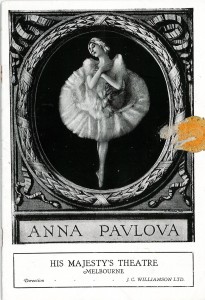
J.C. Williamson Ltd has been instrumental in presenting some of the world’s greatest ballet dancers to the Australian public. In 1913 Adeline Genee’s company was the first to perform. Along with Pavlova’s seasons of 1926 and 1928 (Box 112 a) they laid the foundations for the development of ballet in Australia. Many international acts followed and on 8 May 1939 Edouard Borovansky established his Dancing Academy in Melbourne; coincidentally World War II provided an opportunity to train Australian dancers. The Borovansky Australian Ballet had its first season at The Comedy Theatre from 9 December 1940 (Box 11 a). After the death of Borovansky, The Australian Elizabethan Theatre Trust in a joint venture with J. C. Williamson Ltd formed The Australian Ballet. It began its inaugural season in Sydney on 2 November 1962 (Box 11 h).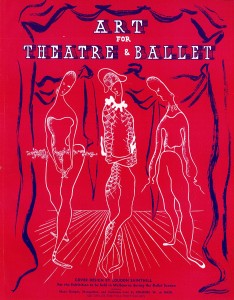
Her Majesty’s Theatre (Melbourne, Brisbane, Sydney) was the home for numerous musical productions from The Maid of the Mountains (Box 108 a [1921]) to La Cage Aux Folles (Box 109 e [1984]). Musicals are still a major part of the cultural fabric of the theatre scene in Australia. Her Majesty’s was also the backdrop for many Gilbert & Sullivan productions (Box 110).
Williamson’s success can be found in his middle-class background, which gave him an understanding of what the public wanted to see; his very popular actress wife was also influential in the company’s triumph. Williamson’s theatrical legacy has significant cogency in the history of cultural production in Australia and New Zealand. His legacy transverses the worlds of drama, ballet, opera, comedy and musical. This historical overview endeavours to entice the reader to find out more by visiting Concert and Theatre Programs listings online.
- Elizabethan Trust News: J. C. Williamson’s Theatres Ltd. Centenary Year 1974 (July 1974) p. 4–5 (Box 96 k).
- “The History of the Firm” in The Royal Ballet [1959] (Box 112 e).
- Opening Souvenir Comedy Theatre [28th April 1928] (Box 104 a).
Dr Nigel Abbott
Nigel has worked on the Concert and Theatre Programs collection as a volunteer since 2012, developing and listing the collection, which now numbers well over one hundred boxes.
Categories

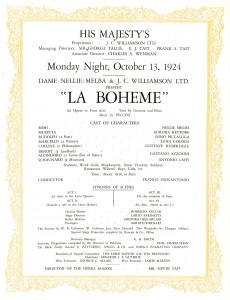
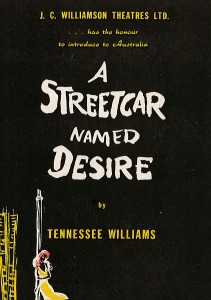
Leave a Reply